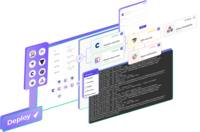➕📊 🚀 Helm chart post deployment
Add a post-deployment workflow that run helm chart to install the applications on a provisioned Kubernetes cluster. Helm is a package manager for Kubernetes that allows you to manage, install and upgrade Kubernetes applications, called charts. Terraform is an infrastructure as code tool that allows you to provision and manage infrastructure across multiple cloud providers. Here are a few use cases where Helm and Terraform can be used together: Deploying Kubernetes clusters: Terraform can be used to provision and manage the underlying infrastructure for a Kubernetes cluster, such as creating virtual machines, load balancers, and storage resources. Helm can then be used to deploy and manage the Kubernetes resources, such as pods, services, and ingresses. Managing multiple environments: Terraform can be used to create and manage different environments, such as development, staging, and production, while Helm can be used to deploy the same chart to each environment with different configurations. Deploying and scaling microservices: Helm can be used to deploy and manage microservices on a Kubernetes cluster, while Terraform can be used to provision and manage the underlying infrastructure, such as load balancers, storage, and auto-scaling groups. Automating deployments: Terraform can be integrated with a CI/CD pipeline to automate the provisioning and management of infrastructure, while Helm can be used to automate the deployment and management of Kubernetes resources. Using modules: Terraform modules can be used to package and share infrastructure configurations, while Helm charts can be used to package and share Kubernetes configurations, allowing teams to work together more efficiently. It's important to note that Helm and Terraform are complementary technologies and can be used together to manage your infrastructure and applications in a more efficient and automated way.
Attached images
Discussion
Voters
 Powered by FeedBear
Powered by FeedBear
